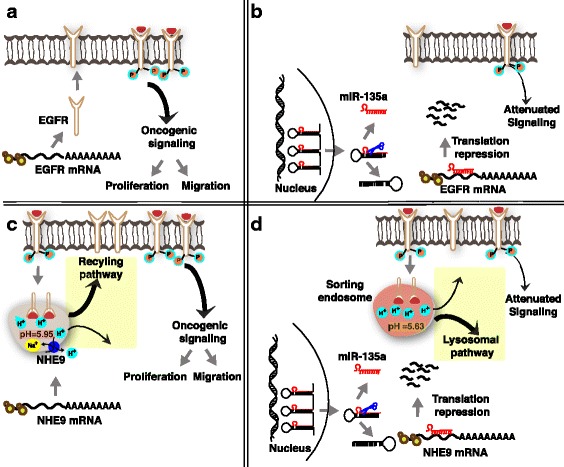Fig. 7.

Model for two-pronged regulation of EGFR signaling by miR-135a. Downregulation of EGFR and NHE9 expression in U87 cells by miR-135a affects glioblastoma cell proliferation and migration. miR-135a reduces the total number of EGFRs by downregulating total cellular EGFR expression and limits the (already) low EGFRs from reaching plasma membrane by downregulating NHE9 expression. a In U87 glioblastoma cells, miR-135a expression is downregulated. EGFR transcript is translated in the cytosol and the receptors are transported to the cell surface. EGF binding activates downstream signaling, which could turn oncogenic due to EGFR persistence on the plasma membrane leading to increased cell proliferation and migration. b Upon expression of miR-135a gene, pre-miRNA 135a is transported out of the nucleus and is processed in the cytoplasm resulting in mature miR-135a. Mature miR-135a binds to the 3’UTR of EGFR transcript resulting in degradation of the mRNA. As a consequence of overall decrease in EGF receptors, oncogenic signaling is attenuated resulting in decreased cell proliferation and migration. c Endocytosed receptors are sorted in the early/sorting endosome either for recycling or degradation in the lysosome. Luminal pH in the sorting endosome regulates the route of their cargo. pH in these endosomes is governed by pump-leak mechanisms [7]. NHE9 expression allows for protons to leak out in exchange for Na+ or K+ ions, thereby alkalinizing the lumen (pH = ~5.95). EGFR is trafficked in pH-defined endosomal compartments within the cell. Increased leak due to NHE9 expression has been shown to recycle EGFR receptors back to the cell surface [7]. d In this model, we show that downregulation of NHE9 expression via miR-135a acidifies the pH in the lumen of sorting endosomes (pH = ~5.63). Loss of NHE9 activity diverts the EGF receptors away from the plasma membrane towards the lysosomes, thus decreasing the number of EGFRs available for oncogenic signaling
